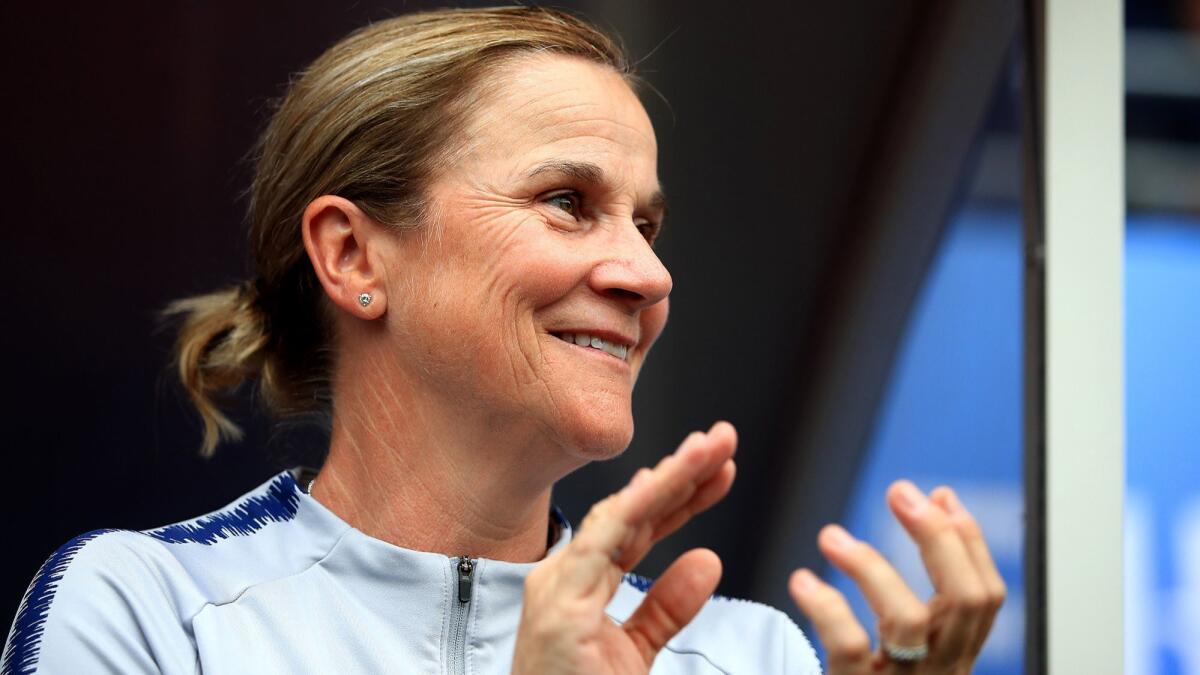Column: Jill Ellis came to America to prosper in soccer, and now, the world is catching up

Reporting from Lyon, France — When the U.S. and England square off in Tuesday’s Women’s World Cup semifinal, the opposing coaches will share a lot of similarities — and one very big difference.
Both were born in England to fathers who worked in soccer. Both were accomplished players and both have brothers who played and coached the sport as well.
But while England’s Phil Neville did all that without having to stray more than an hour from his boyhood home in Manchester, Jill Ellis had to cross an ocean for the chance to play organized soccer, which was banned for girls in England and other parts of Europe for much of the 20th century.
“I grew up playing with boys in the yard and my brother in the backyard and boys in the schoolyard,” said Ellis, who captained her Virginia high school team to a state title and won a U-19 national championship with her club team less than four years after moving to the U.S. in 1981. “I just loved the sport, loved the game and was fortunate, really, to move to the States and to have an opportunity to play organized football.
“I truly think if I had stayed in England, I’m not sure I would be coaching. So what America gave me was kind of a dream and the opportunity and ability to follow that path, which I really had never dreamed about. I just feel very fortunate to be here.”
Ellis, 52, has given back to American soccer tenfold. Not only did she and the rest of her family become naturalized citizens, but Ellis has gone on to coach more games, 125, for the women’s national team than anyone in history. Only the late Tony DiCicco, with 105, has more national team victories than Ellis’ 100, on either the men’s or women’s side.
Of more importance is the fact that Ellis is unbeaten in 12 Women’s World Cup games over two tournaments, and if her team gets by England and Neville on Tuesday, then successfully defends its title next weekend, she will become just the second coach to win two titles on soccer’s biggest stage.
Italy’s Vittorio Pozzo was the first and he did it in 1934-38, when the game was played with leather balls, without substitutions and with goalkeepers who played barehanded, just like everyone else.
But if Ellis’ success speaks to the importance of immigration, opportunity and passion, it also speaks to the growth of the women’s game.
Women’s soccer was popular in much of Europe in the first half of the 20th century, with games in England regularly drawing crowds in the tens of thousands. But by the middle of the century the game had been banned for females across much of the continent, including in Germany, the Netherlands, Italy and France.
All four countries made the quarterfinals of the Women’s World Cup this summer.
The true reasons for the bans varied by country but the those given were generally much the same: The game was too tough for girls.
In France “there was too great a risk” the sport would make women masculine. In Germany, women were considered too frail and too prone to injury, while in England, the Football Assn. closed its facilities to women, arguing publicly that soccer damaged women’s bodies.
Sign up for our weekly soccer newsletter »
The real reasons might have been more sinister. In her 2017 documentary “When Football Banned Women,” Clare Balding shows that the FA could have been motivated more by a fear that the women’s game was becoming more popular than the men’s after a 1920 Boxing Day game at Everton’s Goodison Park drew a crowd of 53,000, a record for a women’s club match. Another 14,000 were turned away.
Less than a year later, the FA outlawed women’s soccer, a ban that lasted half a century. The attendance record stood even longer, falling less than four months ago when 60,739 attended a Spanish league match between Barcelona and Atletico Madrid.
In the weeks following that game in Madrid, a club match in Italy drew a sell-out crowd of 39,000, a record 25,907 showed up for a league game in France and 43,264 attended the FA Cup final — yes, that FA — between Manchester City and West Ham at London’s Wembley Stadium.
The international game might be even more popular, thanks in part to a Women’s World Cup that Europe has dominated, sending seven teams to the quarterfinals and three to the final four.
France’s five games averaged more than 10 million viewers on local TV, more than double the previous national record for a women’s match. England’s first five Women’s World Cup games on the BBC have nearly doubled the audience from four years ago in Canada, and Brazil’s round-of-16 game with France was watched by more than 35 million people on Globo, the largest domestic audience ever for a women’s soccer game.
Records for a women’s soccer broadcast also fell in Sweden, Australia, China and Italy. The viewers are tuning in for one major reason: the game is more exciting, better played and more competitive than ever.
The FA has no reason to worry; there’s no longer a danger the women will eclipse the men. Women long ago put to shame the argument they can’t play the game, and as sponsorship money and other investments follow the public’s interest into the game, it’s only going to get better.
“There are a lot of programs, a lot of teams now that have the backing of federations, the growth of the game domestically,” Ellis said. “You see this with Holland, you see this with Italy. It’s a matter of time.
“I had to leave my home country to go and experience the game. Now, it’s delightful that these countries are actively supporting women’s football. To me, it’s a natural part of the progression when you have an established culture, you now have the right of women to play. It wasn’t there 20 years ago. You see the sophistication tactically. You see the technical capacity.
“As a fan of the game and someone who grew up in Europe when it wasn’t that way, it’s great to see.”
[email protected] | Twitter: @kbaxter11







